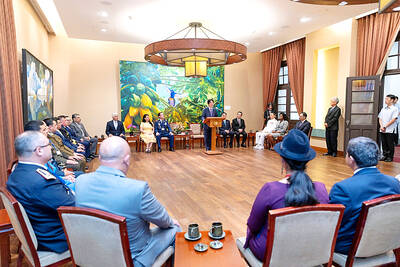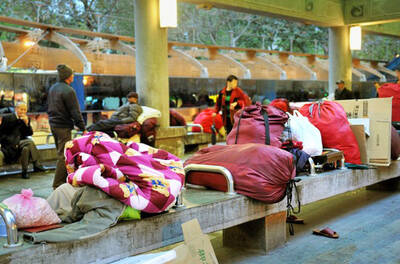The Centers for Disease Control (CDC) has developed a test kit that can diagnose whether someone is infected with swine flu within six hours, an official said yesterday.
CDC Deputy Director-General Shih Wen-yi (施文儀) demonstrated how the kit works and the procedure for the diagnostic test at the CDC-run Kunyang laboratory in Taipei.
Shih said that the Department of Health (DOH) acquired the key DNA sequence of the new virus strain on April 25 from the US Centers for Disease Control and Prevention and two days later obtained the RNA of the virus from the Miaoli-based Animal Technology Institute of Taiwan.
Using this information, the DOH was able to develop and produce the quick-test kit, which will be distributed for use by the government and some laboratories, Shih said.
Taiwan’s quarantine authorities began to make on-board checks of passengers on flights arriving from Canada and the US on Wednesday in an effort to stop the disease, which has spread to 11 countries since it emerged in Mexico last month, from spreading to Taiwan.
Three categories are used to describe the status of potential infection: under investigation, probable case and confirmed case, and the test kit will be used in the first stage of diagnosis, Shih said.
If someone tests positive using the kit, a laboratory will then conduct virus isolation and virus antibody testing to obtain a more accurate diagnosis, he said.
As of yesterday, 12 out of 18 cases of people suspected to be infected with swine flu had tested negative for the virus.
Final results for the remaining six people, who recently arrived from North America, were not yet available.
Shih said that the CDC would stage an exercise at Taipei Songshan Airport today to simulate how an individual suspected of swine flu would be escorted from the airport to the Taipei Municipal Hoping Hospital.
“We need to demonstrate to the public how a suspect swine case will be taken care of,” he said.
Shih said the tests would be carried out at Songshan instead of Taiwan Taoyuan International Airport because the public and the media have questioned safety measures at the airport, which sees the second-largest amount of arrivals from China.
Meanwhile, Premier Liu Chao-shiuan (劉兆玄) inspected the CDC’s storehouse for disease prevention equipment yesterday afternoon.
The CDC has a store of masks that could be distributed to the public if necessary, he said.
“Masks and other disease prevention equipment can be distributed to anywhere in Taiwan proper within 24 hours, and to outlying islands within 48 hours. There is no need for people to buy them in a panic,” Liu said.
Liu said the government would enforce the Communicable Disease Prevention and Control Act (傳染病防治法) to prevent the hoarding of masks.
Under Article 61 of the act, hoarding medical equipment is punishable by one to seven years in prison and up to NT$5 million (US$150,000) in fines.
Taiwan High Court Prosecutors’ Office Chief Yen Da-ho (顏大和) said that prosecutors have been asked to investigate whether any businesses were trying to illegally profit by raising the price of related medical items.
ADDITIONAL REPORTING BY SHIH HSIU-CHUAN

Costa Rica sent a group of intelligence officials to Taiwan for a short-term training program, the first time the Central American country has done so since the countries ended official diplomatic relations in 2007, a Costa Rican media outlet reported last week. Five officials from the Costa Rican Directorate of Intelligence and Security last month spent 23 days in Taipei undergoing a series of training sessions focused on national security, La Nacion reported on Friday, quoting unnamed sources. The Costa Rican government has not confirmed the report. The Chinese embassy in Costa Rica protested the news, saying in a statement issued the same

Taiwan’s Liu Ming-i, right, who also goes by the name Ray Liu, poses with a Chinese Taipei flag after winning the gold medal in the men’s physique 170cm competition at the International Fitness and Bodybuilding Federation Asian Championship in Ajman, United Arab Emirates, yesterday.

A year-long renovation of Taipei’s Bangka Park (艋舺公園) began yesterday, as city workers fenced off the site and cleared out belongings left by homeless residents who had been living there. Despite protests from displaced residents, a city official defended the government’s relocation efforts, saying transitional housing has been offered. The renovation of the park in Taipei’s Wanhua District (萬華), near Longshan Temple (龍山寺), began at 9am yesterday, as about 20 homeless people packed their belongings and left after being asked to move by city personnel. Among them was a 90-year-old woman surnamed Wang (王), who last week said that she had no plans

TO BE APPEALED: The environment ministry said coal reduction goals had to be reached within two months, which was against the principle of legitimate expectation The Taipei High Administrative Court on Thursday ruled in favor of the Taichung Environmental Protection Bureau in its administrative litigation against the Ministry of Environment for the rescission of a NT$18 million fine (US$609,570) imposed by the bureau on the Taichung Power Plant in 2019 for alleged excess coal power generation. The bureau in November 2019 revised what it said was a “slip of the pen” in the text of the operating permit granted to the plant — which is run by Taiwan Power Co (Taipower) — in October 2017. The permit originally read: “reduce coal use by 40 percent from Jan.